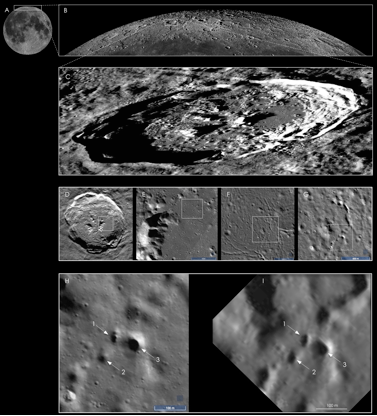FTA: 11 January 2018, Mountain View, CA –The SETI Institute and the Mars Institute announced today the discovery of small pits in a large crater near the North Pole of the Moon, which may be entrances to an underground network of lava tubes. The pits were identified through analysis of imaging data from NASA’s Lunar Reconnaissance Orbiter (LRO). If water ice is present, these potential lava tube entrances or “skylights” might allow future explorers easier access to subsurface ice, and therefore water, than if they had to excavate the gritty ice-rich “regolith” (surface rubble) at the actual lunar poles.
The new pits were identified on the northeastern floor of Philolaus Crater, a large, 43 mile (70 km)-diameter impact crater located at 72.1oN, 32.4oW, about 340 miles (550 km) from the North Pole of the Moon, on the lunar near side. The pits appear as small rimless depressions, typically 50 to 100 feet across (15 to 30 meters), with completely shadowed interiors. The pits are located along sections of winding channels, known on the Moon as “sinuous rilles,” that crisscross the floor of Philolaus Crater. Lunar sinuous rilles are generally thought to be collapsed, or partially collapsed, lava tubes, underground tunnels that were once streams of flowing lava.

Hi! I am a robot. I just upvoted you! I found similar content that readers might be interested in:
https://www.seti.org/seti-institute/press-release/possible-lava-tube-skylights-discovered-near-north-pole-moon